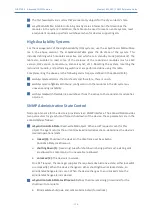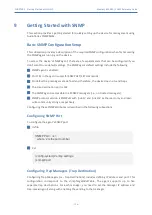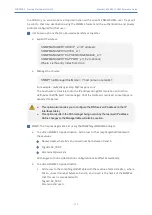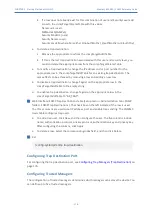
CHAPTER 9 Getting Started with SNMP
Mediant 800 SBC | SNMP Reference Guide
■
The device allows a manager to determine which alarms are currently active in the device.
That is, the device maintains an active alarm table.
■
The device allows a manager to detect lost alarms and clear notifications (sequence
number in trap, current sequence number MIB object).
■
The device allows a manager to recover lost alarm raise and clear notifications (maintains a
log history).
■
The device sends a cold start trap to indicate that it is starting. This allows the manager to
synchronize its view of the device's active alarms.
When SNMP alarm traps are sent, the carrier-grade alarm system does not add or delete alarm
traps as part of the feature. This system provides the mechanism for viewing history and
current active alarm information.
As part of CGA, the device supports the following:
■
Active Alarm Table: The device maintains an active alarm table to allow an OVOC to
determine which alarms are currently active in the device. Two views of the active alarm
table are supported by the agent:
●
acActiveAlarmTable in the proprietary AcAlarm MIB (this is a simple, one-row per
alarm table that is easy to view with a MIB browser)
●
alarmActiveTable and alarmActiveVariableTable in the IETF standard AcAlarm MIB
(rooted in the MIB tree)
■
Alarm History: The device maintains a history of alarms that have been sent and traps that
have been cleared to allow an OVOC to recover any lost sent or cleared traps. Two views of
the alarm history table are supported by the agent:
●
acAlarmHistoryTable in the proprietary AcAlarm MIB (this is a simple, one-row per
alarm table that is easy to view with a MIB browser)
●
nlmLogTable and nlmLogVariableTable in the standard NOTIFICATION-LOG-MIB
- 184 -



































